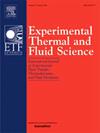Flow and wave characteristics of jet drainage film under crossflow
IF 3.3
2区 工程技术
Q2 ENGINEERING, MECHANICAL
Experimental Thermal and Fluid Science
Pub Date : 2025-09-10
DOI:10.1016/j.expthermflusci.2025.111616
引用次数: 0
Abstract
The interaction between jet drainage films and crossflow is widespread in engineering systems such as liquid rocket engines and nuclear reactor emergency cooling systems. In these processes, an understanding of the flow behavior and fluctuation characteristics of drainage films under crossflow is essential. In this study, an experimental system was constructed to investigate the behavior of jet drainage films under crossflow. The spatial evolution of film offset, average film thickness, base film thickness, wave height, and fluctuation characteristics was investigated under varying crossflow velocities using high-speed imaging and spectral confocal measurement techniques. The results show that the drainage film is shifted to the crossflow direction, and the offset increases linearly with the flow distance, which is inversely proportional to the jet Weber number and directly proportional to the crossflow Weber number. The spatial distribution characteristics of the average liquid film thickness, base film thickness, and wave height are jointly influenced by the jet Weber number and crossflow velocity. The cross-sectional averages of liquid film thickness, base film thickness, and wave height exhibit an initial decrease followed by a subsequent increase with flow distance. The standard deviation of the liquid film thickness was significantly and linearly correlated with its average value, with a slope of approximately 0.3. As the crossflow velocity increases, the liquid film fluctuations on the leeward side of the drainage film are significantly suppressed at low jet Weber numbers, while the liquid film fluctuations on the windward side are notably weakened at the high jet Weber number.
横流作用下射流疏水膜的流动和波动特性
射流排水膜与横流之间的相互作用在液体火箭发动机和核反应堆应急冷却系统等工程系统中广泛存在。在这些过程中,了解排水膜在横流作用下的流动行为和波动特征是至关重要的。在本研究中,建立了一个实验系统来研究横流作用下射流疏水膜的行为。利用高速成像和光谱共聚焦测量技术,研究了不同横流速度下的膜偏移量、平均膜厚、基膜厚度、波高和波动特性的空间演变。结果表明:疏水膜向横流方向偏移,偏移量随流动距离的增加呈线性增加,与射流韦伯数成反比,与横流韦伯数成正比;射流韦伯数和横流速度共同影响平均液膜厚度、基膜厚度和波高的空间分布特征。液膜厚度、基膜厚度和波高的截面平均值随着流动距离的增加呈现先减小后增大的趋势。液膜厚度的标准差与其平均值呈显著线性相关,斜率约为0.3。随着横流速度的增加,低射流韦伯数时疏水膜背风侧液膜波动被显著抑制,高射流韦伯数时迎风侧液膜波动被显著减弱。
本文章由计算机程序翻译,如有差异,请以英文原文为准。
求助全文
约1分钟内获得全文
求助全文
来源期刊

Experimental Thermal and Fluid Science
工程技术-工程:机械
CiteScore
6.70
自引率
3.10%
发文量
159
审稿时长
34 days
期刊介绍:
Experimental Thermal and Fluid Science provides a forum for research emphasizing experimental work that enhances fundamental understanding of heat transfer, thermodynamics, and fluid mechanics. In addition to the principal areas of research, the journal covers research results in related fields, including combined heat and mass transfer, flows with phase transition, micro- and nano-scale systems, multiphase flow, combustion, radiative transfer, porous media, cryogenics, turbulence, and novel experimental techniques.
 求助内容:
求助内容: 应助结果提醒方式:
应助结果提醒方式:


